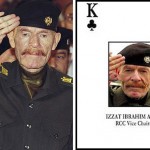Last of Saddam Hussein’s top henchmen – who was ‘King of Clubs’ in US military’s “Deck of 55” most-wanted Iraqis – reportedly killed in military operation against Isil
One of Saddam Hussein’s last surviving henchmen has been killed near the northern city of Tikrit after helping to mastermind Iraq’s insurgency, officials said on Friday.
The body of Izzat Ibrahim al-Douri, who spent 24 years as Saddam’s deputy on the Revolutionary Command Council, was discovered on a battlefield after he was killed by Iraqi soldiers and allied Shia militiamen, according to Raed al-Jubouri, the governor of Salahuddin province.
Douri, 72, was one of “12 terrorists” who died, added Mr Jubouri.
Douri evaded capture for 12 years after Saddam’s downfall, reinventing himself as the leader of the Naqshbandi Order, one of Iraq’s main Sunni insurgent groups dedicating to fighting the Shia-led government.
More recently, Douri allied with the terrorists of the Islamic State of Iraq and the Levant (Isil).
Along with other former pillars of Sadddam’s regime, he gave Isil a backbone of military professionalism and experience, along with access to smuggling networks which developed when Iraq was crippled by sanctions in the 1990s.
Douri’s death has been falsely reported before. This time, the authorities released a photograph purporting to be of his body with a distinctive red beard. The government promised to carry out DNA testing to establish Douri’s fate.
After the Anglo-American invasion in 2003, the US military developed a set of playing cards to help troops identify the “most wanted” members of Saddam’s regime. Douri appeared as the king of clubs.
But he evaded capture and went on to mastermind attacks on US forces and Iraq’s new government. For years, Douri was believed to be in Syria, but he retained an operational role in the insurgency and played a part in Isil’s offensive. When the terrorists seized the city of Mosul last June, Douri released an audio recording praising Isil and urging Iraqis to join its effort to “liberate” the country.
But the relationship between Isil and the Naqshbandi Order has soured, apparently over issues including the murder of Moaz al-Kasasbeh, the Jordanian pilot who was burned to death in February.
If confirmed, Douri’s death would be “important, but not a game-changer”, said Charlie Winter, a Middle East researcher at the London-based Quilliam Foundation, adding that the Naqshbandi Order’s importance to Isil had diminished as their alliance has weakened.
Isil suffered a defeat this month when it was expelled from Tikrit in a government offensive. The terrorists are now striking back in cities such as Ramadi.
Douri, who was born in 1942, first met Saddam in 1963 after an abortive Ba’athist coup in Baghdad. He led a special unit charged with murdering enemies of the Ba’athists, mainly members of the Iraqi communist party.
When the Ba’athists seized power in the revolution of 1968, Douri was made interior minister, allowing him to continue his hunting down opponents.
When Saddam seized the presidency in 1979, Douri was one of the prime movers behind the plot. The alliance between the two men was sealed in dynastic fashion with the marriage of Douri’s daughter, Suha, to Saddam’s eldest son, Uday.
Douri found his niche as deputy chairman of the Revolutionary Command Council, the apex of the Ba’ath party structure. Saddam entrusted him with the regime’s most sensitive tasks.
Douri helped to mastermind the “Anfal” campaign against the Kurdish minority, which claimed at least 100,000 lives in 1987-88. He was on the committee that ordered scores of gas attacks, including the assault on the town of Halabja in March 1988 when 5,000 died.
Afterwards, he gloated over the slaughter. When the Kurds rebelled again in 1991, he told them: “If you have forgotten Halabja, I would like to remind you that we are ready to repeat the operation.”
During the countdown to Saddam’s overthrow, Douri stood before the world’s press and announced the result of a referendum on the dictator’s rule in October 2002. He declared that 11,445,638 Iraqis were on the electoral roll and, of these, 11,445,638 had voted “Yes” to Saddam.


Thanks Gord, sensei and Marco! And to anwesr your question Marco, yes, it is kind of like painting, or at least there’s a common relationship there. I did a lot of drawings like this in art school, so it’s fun to do these as quick studies. I feel I can get a lot more information down on paper a lot faster. I’d like to get a bigger book with this type of paper. The one I’ve been sketching these in is quite small, about the size of a paperback book.